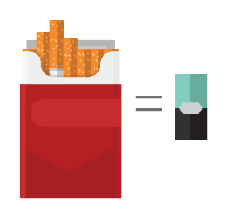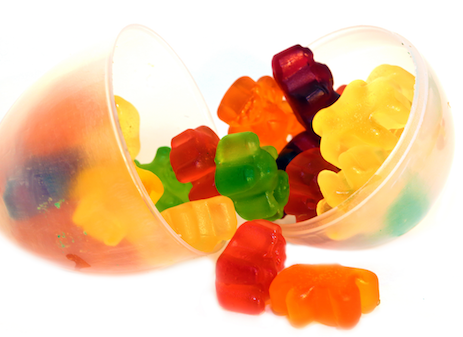TOOLKIT FOR THE MASSAPEQUAS
Let’s talk about Vaping

18% of Massapequa youth (grades 7-12) reported using an electronic vaping device in the past 30 days.*
- Vapes, also known as e-cigarettes, are battery powered electronic nicotine delivery systems (ENDS). The battery heats an e-liquid/e-juice which turns into an aerosol [Center on Addiction (CoA)].
- JUUL, the most popular ENDS amongst youth resembles a USB flash drive, making it easy to hide (CoA). One pod is equivalent to 20 cigarettes (one pack).
- E-cigarettes are not a proven method to quit smoking. Evidence suggests that use increases the likelihood of future cigarette smoking (US Food & Drug Administration; CoA).
- Nicotine use during adolescence interferes with brain development and increases the risk for future addiction to other drugs (National Cancer Institute’s (NCI) smokefree.gov Initiative).
- As of October 8, 2019, 1,299 lung injury cases associated with vaping products have been reported to the Centers for Disease Control and Prevention (CDC). Twenty-six deaths have been confirmed in 21 states. The CDC recommends refraining from using vaping products, particularly those containing THC (CDC).
Download the MTAC Toolkit for the Massapequas Volume 1 - Let's talk about Vaping >>
See the MTAC Video - Let's talk about Vaping >>
What’s in that Vape?

Of MHS seniors (41%) who reported vaping in the past 30 days, the substances vaped were “flavoring” (21%); nicotine (30%); marijuana, hash oil or dabs (12%), other (2.2%) and didn’t know (2.5%).*
E-cigarettes contain nicotine, ultrafine particles, heavy metals, and volatile organic compounds
- Although regulated by the Food and Drug Administration (US FDA) vape pods/cartridges typically contain nicotine, as well as varying compositions of flavorings, propylene glycol, vegetable glycerin, and other ingredients (USFDA).
- Other substances are also being vaped in pods/cartridges (Center on Addiction). In the past six months, 60 vape cartridges were found in the Massapequa Preserve with many testing positive for Cocaine, THC, Ephedrine, Meth and Heroin.
- Attractive flavors like mango and fruit medley makes vaping more appealing to adolescents. (Center on Addiction).
- The aerosol from e-cigarettes contains harmful chemicals including nicotine, ultrafine particles that can be inhaled deep into the lungs, flavoring such as diacetyl, a chemical linked to a serious lung disease, volatile organic compounds and heavy metals (US Surgeon General). A Mayo Clinic study finds that lung injuries from vaping most likely are caused by direct toxicity or tissue damage from noxious chemical fumes (Science Daily 10.2.19).
Download the MTAC Toolkit for the Massapequas Volume 2 - What's in a Vape? >>
See the MTAC Video - What's in a Vape? >>
Marijuana Then and Now - It’s not what you think!

In the Massapequas, youth (grades 7-12) who reported using marijuana, began initial use before the age of fifteen.*
- Today’s marijuana is much more potent than it was in the past. THC content, the psychoactive ingredient in marijuana, has tripled its potency than from the early 1990s (NIDA 2019).
- Marijuana oils and waxes are being vaped which delivers much higher levels of THC. This presents a higher risk of negative health effects and may cause psychosis or panic attacks, leading to treatment in the emergency room. Marijuana exposure during adolescent development can cause long-term or possibly permanent adverse changes in the brain (NIDA).
- Today, almost any food (gummies, brownies, lollipops, etc.), can be infused with marijuana. The amount of THC concentration in edibles varies and consequently overdose symptoms are often more severe (US DEA).
- Approximately 1 in 10 people who use marijuana will become addicted. When they start before age 18, the rate of addiction rises to 1 in 6 (SAMHSA).
Download the MTAC Toolkit for the Massapequas Volume 3 - Marijuana Then and Now - It’s not what you think! >>
See the MTAC Video - Marijuana Then and Now >>
Marijuana and the brain

In the Massapequas, 22% of twelfth grade students and 12% of eleventh grade students reported using marijuana in the past 30 days.*
- Marijuana can cause permanent IQ LOSS - as much as 8 points – when people start using it at a young age. These IQ points do not come back, even after giving up marijuana (SAMHSA). How might that affect teen SAT scores?
- Compared with teens who don’t use, students who use marijuana are more likely not to finish high school or get a college degree (SAMHSA).
- Research shows that marijuana affects timing, movement, and coordination, which can harm athletic performance as well as impact activities like driving (NIDA).
- THC, the chemical responsible for most of marijuana’s psychological effects, affects cells throughout the brain, including cells in circuits related to learning and memory, coordination, and addiction (SAMHSA).
Download the MTAC Toolkit for the Massapequas Volume 4 - Marijuana and the brain >>
See the MTAC Video - Marijuana and the brain >>
Signs & symptoms of marijuana use

63%of Massapequa youth (grades 7-12) do not think people are at great risk of harming themselves (physically or in other ways) if they use marijuana once or twice a week.*
- Marijuana adverse effects include increased heart rate, extreme confusion, anxiety, paranoia, panic, delusions or hallucinations, increased blood pressure, severe nausea or vomiting, respiratory infection, and greater likelihood of addiction [Center on Addiction (CoA)].
- Common Signs of Marijuana Use in Teens include**
- Acting very silly and out of character for no reason
- Using new words and phrases like "sparking up," "420," "dabbing," and "shatter"
- Having increased irritability
- Losing interest in and motivation to do usual activities
- Spending time with peers that use marijuana
- Having trouble remembering things that just happened
- Carrying pipes, lighters, vape pens, or rolling papers
- Coming home with red eyes and/or urges to eat outside of usual meal times
- Stealing money or having money that cannot be accounted for**
- Be aware, vaping marijuana often goes undetected since it does not create a smell. The CDC has informed users to refrain from using e-cigarettes or vaping products, particularly those containing THC, due to recent outbreaks with lung injuries and death from vaping.
Download the MTAC Toolkit for the Massapequas Volume 5 - Signs & symptoms of marijuana use >>
See the MTAC Video - Signs & symptoms of marijuana use >>
Let’s talk about Marijuana

57% of youth (grades 7-12) in the Massapequas reported they have talked with a parent in the past year about the dangers of drug use.*
- Talk with your children about the danger of marijuana at an early age to help them make better choices. Youth are less likely to try marijuana if they can ask parents for help and know exactly how their parents feel about drug use.**
- Ask what they have heard about using marijuana. Listen carefully, pay attention, and try not to interrupt. Avoid making negative or angry comments. Offer facts about the risks and consequences of smoking/ingesting/vaping marijuana.**
- Explain that research tells us that the brain continues to mature into the 20s. While it is developing, there is greater risk of harm from marijuana use.**
- Talk about having an “exit plan” if they are offered marijuana. Talk about what they would do if faced with a decision about drugs, such as texting a code word to a family member. Be sure to practice the exit plan in a safe environment (SAMHSA).
Download the MTAC Toolkit for the Massapequas Volume 6 - Let’s talk about Marijuana >>
See the MTAC Video - Let’s talk about Marijuana >>
Marijuana and driving

10% of Massapequas’ 11th/12th grade students reported driving a car after they had been using marijuana or other drugs.*
- Marijuana’s effects on driving include***
- poor attention to task; poor time and distance perception
- slower braking and reaction time
- poor speed maintenance
- poor lane tracking and more steering corrections
- Research shows an increase in crash risk with marijuana use. The combined use of alcohol and marijuana together is common among seriously and fatally injured drivers. ****
- Since recreational marijuana was legalized in Colorado, traffic deaths involving drivers who tested positive for marijuana more than doubled from 55 in 2013 to 115 people killed in 2018. *****
- This equates to one person killed every 3 days in 2018 compared to one person killed every 6 ½ days in 2013.
Download the MTAC Toolkit for the Massapequas Volume 7 - Marijuana and driving >>
See the MTAC Video - Marijuana and driving >>
The Grass Isn’t Greener on the Recreational Side

Since recreational marijuana was legalized in Colorado, past month marijuana use for ages 12 and older increased by 58% and is 78% higher than the national average – currently ranked 4th in the nation.*****
- Marijuana tax revenue represents approximately nine tenths of one percent of Colorado’s FY 2018 budget. For every $ 1.00 gained in tax revenue, Coloradans spent approximately $ 4.50 to mitigate the effects of legalization.*****
- Since recreational marijuana was legalized in Colorado, traffic deaths in which drivers tested positive for marijuana increased 109 percent while all Colorado traffic deaths increased 31 percent.*****
- In Colorado, the yearly number of marijuana-related hospitalizations increased 101 percent after the legalization of recreational marijuana (2013 compared to 2017).*****
- As of June 2017, there were 491 retail marijuana stores in Colorado compared to 392 Starbucks and 208 McDonald’s.******
Download the MTAC Toolkit for the Massapequas Volume 8 - The Grass Isn’t Greener on the Recreational Side >>
See the MTAC Video - The Grass Isn’t Greener on the Recreational Side >>
This information and the associated collateral was developed, in part, under grant number 1H79SPO80744-01 from the Office of National Drug Control Policy and Substance Abuse and Mental Health Services Administration. The views, opinions, and content of this publication are those of the authors and contributors and do not necessarily reflect the views, opinions, or policies of ONDCP, SAMHSA, or HHS, and should not be construed as such.
References
*Massapequa youth statistics are cited from the New York State Office on Alcoholism and Substance Abuse Services Partnership for Success Student Survey administered in September 2018 in Massapequa Public Schools grades 7-12.
**American Academy of Child and Adolescent Psychiatry
***Compton and Berning, 2015; Hartman and Huestis, 2013; Hartman et al., 2015; Kelly-Baker, 2014
****National Highway Traffic Safety Administration and Colorado Department of Transportation
*****Rocky Mountain High Intensity Drug Trafficking Area: The Legalization of Marijuana in Colorado: The Impact Volume 6 September 2019
******Rocky Mountain High Intensity Drug Trafficking Area: The Legalization of Marijuana in Colorado: The Impact Volume 5 September 2018
See all MTAC Resources for Marijuana >>